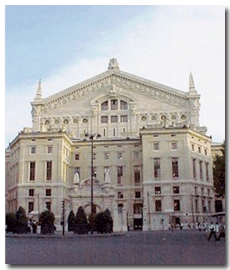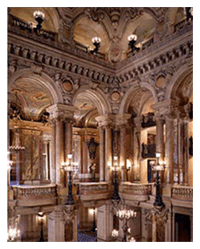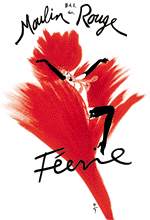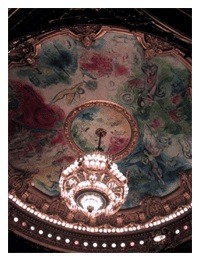Letter from A Parisian Christmas

- SUBSCRIBE
- ALREADY SUBSCRIBED?
BECOME A BONJOUR PARIS MEMBER
Gain full access to our collection of over 5,000 articles and bring the City of Light into your life. Just 80 USD per year.
Find out why you should become a member here.
Sign in
Fill in your credentials below.
Whether you are travelling with children or on your own, whether you are a child at heart or not, the window display at the Bd Haussmann’s Grands Magasins is an unmissable annual pilgrimage, and a renewed enchantment each December. And if you can combine your outing with an evening at the Palais Garnier*, all the better.This show case of Belle Epoque Paris deserves more attention than it has been granted since1989, when it was dethroned by the uninspiring Bastille Opera, following which the young and trendy drifted from western Paris to the east.
Continue along the Boulevard des Capucines and turn left into rue Edouard VII. You will come to Square Edouard VII ;with Landowski’s statue of the British King and the Théâtre Edouard VII-Sacha Guitry on your right. A little further on is the Square de l’Opéra-Louis Jouvet and its theatre, l’Athénée, on the left. This elegant small enclave honours two of the most prominent theatre men of the first half of the century and the Francophile King of England. The square is best appreciated by night, when the street-lamps create a romantic atmosphere and call to mind the splendour of the neighbourhood a century ago.
 Turn right into rue Bourdeau and right into rue Auber. On your left is the old Opera House, Le Palais Garnier*, which can be visited. Like its 20th-century couterpart at La Bastille, it was built for prestige at least as much as for art’s sake. In both cases the world was to be dazzled by the greatest, the most beautiful, the most techically advanced etc. opera house, the quality of the performances themselves not necessarily being top priority. While the Bastille Opera had to be ready at all costs for Bastille Day 1989, Garnier’s monument was meant to coincide with that of 1867-the year of the Universal Exposition-but, owing to shortage of funds and bureaucratic sluggishness, only its façade was ready in time and was unveiled to the public. In both cases a contest was organised by the authorities, and both were won by young unknown architects-the 35-year-old Charles Garnier and the 42-year-old Canadian Cal Ott respectively. The incredible length of time taken to complete both structures and the stupendous costs, which many regarded with a critical eye, are also comparable. But France has always been obsessed by the wish to embody her superlative grandeur in monuments. Opera houses must have been among her favourites it would seem: Since Louis XIV set up his first opera house in 1669, 13 other houses have been erected in the French capital!
Turn right into rue Bourdeau and right into rue Auber. On your left is the old Opera House, Le Palais Garnier*, which can be visited. Like its 20th-century couterpart at La Bastille, it was built for prestige at least as much as for art’s sake. In both cases the world was to be dazzled by the greatest, the most beautiful, the most techically advanced etc. opera house, the quality of the performances themselves not necessarily being top priority. While the Bastille Opera had to be ready at all costs for Bastille Day 1989, Garnier’s monument was meant to coincide with that of 1867-the year of the Universal Exposition-but, owing to shortage of funds and bureaucratic sluggishness, only its façade was ready in time and was unveiled to the public. In both cases a contest was organised by the authorities, and both were won by young unknown architects-the 35-year-old Charles Garnier and the 42-year-old Canadian Cal Ott respectively. The incredible length of time taken to complete both structures and the stupendous costs, which many regarded with a critical eye, are also comparable. But France has always been obsessed by the wish to embody her superlative grandeur in monuments. Opera houses must have been among her favourites it would seem: Since Louis XIV set up his first opera house in 1669, 13 other houses have been erected in the French capital!
 The Empress Eugénie was bewildered by the neo-baroque style of the new edifice and said so bluntly to Charles Garnier, "C’est ni du grec, ni du Louis XIV, pas même du Louis XVI". ("This is neither Greek in style nor Louis XIV, nor even in the
The Empress Eugénie was bewildered by the neo-baroque style of the new edifice and said so bluntly to Charles Garnier, "C’est ni du grec, ni du Louis XIV, pas même du Louis XVI". ("This is neither Greek in style nor Louis XIV, nor even in the  style of Louis XVI"). Although somewhat ruffled, the architect retained enough presence of mind to reply, "Ces styles là
style of Louis XVI"). Although somewhat ruffled, the architect retained enough presence of mind to reply, "Ces styles là
Ont fait leur temps. C’est du style Napoléon III, Madame!" ("Those styles have had their day. This is in the style of Napoeeon III, Madam!").
The painter Renoir was also scandalised by what he called "that lump of an overbaked brioche", and regretted that Big Bertha had missed it during World War I! But some people are rather fond of it and feel that as this is the main example of the magnificence of the Second Empire (although it was inaugurated after its fall), for better or for worse, it should not be lightly dismissed. As you walk up its grand staircase or wander through its splendid foyer, you can picture the scintillating Parisian society parading here in their finery, notably on the opening night, 5 January 1875, which was attended by the President of the Republic, the King of Spain, and the Lord Mayor of London in his ceremonial attire, escorted by his sheriffs, sword-bearers and halberdiers. (Charles Garnier was also present but was made to pay for his seat!).
* The following is excerpted from Romantic Paris, the chapter on Romantic Nights. You will find it on the night entertainment listings.
If Paris of the 19th century speaks to your heart, you cannot forego a night at the Palais Garnier opera house, the ultimate seat of glamorous romance. Echoing Voltaire’s definition of the opera as "the land of fairies", Charles Garnier meant his gigantic sanctuary to be a palace of dreams, girdled by the magic of 3,5000 gas lights. He placed it in the heart of Haussmann’s new Paris, "the capital of capitals", and linked it to the Palais des Tuileries, the seat of the Imperial family, by an imperial thoroughfare, the avenue de l’Opéra, then the city’s most elegant artery. Haussmann thought that the addition of trees would spoil it, which is why it is the only treeless avenue in Paris to this very day.
 A stunning façade completed the monument, a drop curtain of polychrome marble and gilt bronze. As you walk into the opera foyer and up its dazzling staircase, imagine rustling silk and glittering diamonds, the agitated fans, the top hats and tails, the hubbub of the city’s gossip. The glamour contiues into the auditorium, all red and gold and topped by Marc Chagall’s exquisite ceiling, where some of the world’s most famous lovers float in ethereal hues-Orpheus and Eurydice, Tristan and Isolde, Tamino and Pamina, and, of course, Romeo and Juliet.
A stunning façade completed the monument, a drop curtain of polychrome marble and gilt bronze. As you walk into the opera foyer and up its dazzling staircase, imagine rustling silk and glittering diamonds, the agitated fans, the top hats and tails, the hubbub of the city’s gossip. The glamour contiues into the auditorium, all red and gold and topped by Marc Chagall’s exquisite ceiling, where some of the world’s most famous lovers float in ethereal hues-Orpheus and Eurydice, Tristan and Isolde, Tamino and Pamina, and, of course, Romeo and Juliet.
From the centre of the ceiling hangs a dazzling seven-tonne chandelier, shining with 350 lights, the very one that crashed down in The Phantom of the Opera.
Today full-scale operas are performed at the Bastille opera house, alas, which cannot boast the miraculous acoustics of the Palais Garnier, but you can enjoy here wonderful ballets and chamber operas such as Mozart’s. Make sure to check the programme before you come to town. You may even be able to attend a general rehearsal for a few euros. Ask at your hotel.
Palais Garnier
place de l’Opéra, 75009
Tel: 08 36 69 78 68
 To find out more about the Palais Garnier and the full story of the 9th arrondissement, look up Around and About Paris,Volume II by Thirza Vallois, published by Iliad Books.
To find out more about the Palais Garnier and the full story of the 9th arrondissement, look up Around and About Paris,Volume II by Thirza Vallois, published by Iliad Books.
For further information as to where to stay, eat, shop and be entertained in the 9th arrondissement, look up Romantic Paris, by Thirza Vallois, published by Arris Books.
To order your copies of Around and About Paris and Romantic Paris:
http://www.thirzavallois.com


